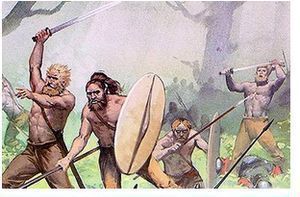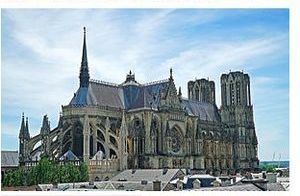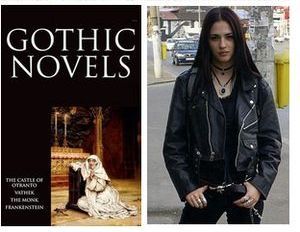Learn a Little Lit—Goths to Gothic
 What's an ancient German tribe have in common with medieval church architecture?
What's an ancient German tribe have in common with medieval church architecture?
And what do flying buttresses have to do with horror fiction?
Finally, what's any of it got to do with black lipstick and body piercing?
Goth. Gothic. What do those terms mean, and how are they related? So let's find out.
The 1st piece of the puzzle starts with the GOTHS, a Germanic tribe mentioned by the Greeks way back in the 4th century B.C. We know them, of course, as the group that sacked Rome 700 years later, in 410 A.D.
For the 2nd clue, skip ahead to the 11th and 12th centuries, long after the fall of Rome, when a new form of architecture — featuring pointed arches, vaulted ceilings, and flying buttresses — sprung up in Western Europe. That design led to the great medieval castles and cathedrals.  Although today we refer to the style as GOTHIC, at the time it was called "French Work" because of its origin in France.
Although today we refer to the style as GOTHIC, at the time it was called "French Work" because of its origin in France.
But now jump to 1453 and the fall of the eastern remnant of the Roman Empire to the Ottomans. Driven out by the collapse of Constantinople, Greek scholars fled to the West, carrying with them the writings of the ancient Greeks and Romans.
Widely read throughout Europe, the classical writings were a revelation, sparking a rebirth — which we now call the Renaissance — in all branches of culture, including architecture. The classical Greco-Roman style, with its columns and domes and elegant proportions, became all the rage.
What about those glorious cathedrals and castles? Not so glorious. Seen as old and fusty, they came to be associated with a dark, barbarous past. From "barbarous" it was a short leap in imagination and linguistics to the "barbarians" who destroyed the classical world of Rome — the Goths. So that's how we got to GOTHIC architecture. The 3rd clue takes us to 1764, when Horace Walpole published The Castle of Otranto: A Gothic Story. The novel — set in a dark, foreboding castle, complete with dungeons, secret pathways, mysterious supernatural elements, and a damsel in distress — was wildly successful, spawning an all new horror genre.
The 3rd clue takes us to 1764, when Horace Walpole published The Castle of Otranto: A Gothic Story. The novel — set in a dark, foreboding castle, complete with dungeons, secret pathways, mysterious supernatural elements, and a damsel in distress — was wildly successful, spawning an all new horror genre.
Over the years, similar types of works followed: Frankenstein, Hunchback of Notre Dame, Dracula, Fall of the House of Usher, and Phantom of the Opera are among the best known. All feature dark eerie settings — sinister castles, abbeys, monasteries, or old manses — that brought to mind the heavy, medieval architecture by then known as Gothic. And so we arrive at the GOTHIC novel.
Gradually, the emphasis of Gothic fiction shifted away from the dreary settings to the creatures at the heart of the stories — monsters, ghosts, ghouls, and vampires — or to the dark, brooding, sometimes villainous, human characters.
The 4th and final piece of the puzzle came in 1979, the year the post-punk band Bauhaus released "Bela Lugoi's Dead." The song refers to the 1931 film Dracula and its Hungarian star, Bela Lugosi. Bauhaus and other post-punk bands are credited with inspiring an underground cultural aesthetic — black clothing, nails, lips, and eyeliner — reminiscent of Gothic fiction. It's GOTH, man.
So here we are: we've gone from the GOTHS to GOTHIC to GOTHIC to GOTH. And it took only 2,300 years.
NEXT UP? We'll talk about the Gothic novel in the 21st Century. Stay tuned.
Site by BOOM
![]()
LitLovers © 2024
